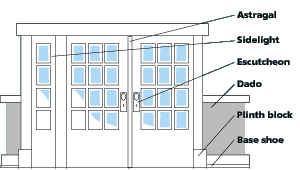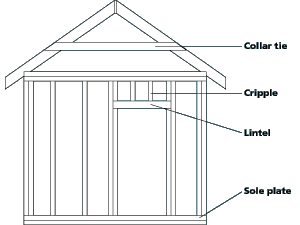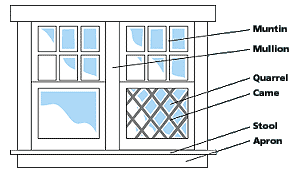In your home you are surrounded by items with obscure names as arcane as any you’ll find on a clipper ship! To help, here is a homeowner’s glossary with building terminology.
But if you don’t feel up to memorizing the following list, relax. That’s what the word thingamajig is for.
Apron. A trim board mounted flat against an interior wall, directly under a window.
 Astragal. A molding attached to the edge of one of a pair of double doors, which serves to prevent them from swinging past one another when closed.
Astragal. A molding attached to the edge of one of a pair of double doors, which serves to prevent them from swinging past one another when closed.
Base shoe. A strip of quarter-round or similar molding that fills the angle between the baseboard and flooring.
Came. A narrow lead strip used to secure small panes of glass in latticed windows; often found in 16th-century houses, as well as in modern homes in the style known as Stockbroker Tudor.
Collar tie. A board or beam fastened between pairs of rafters in a peaked roof, like the crossbar of the letter A, to prevent the rafter ends from forcing the walls outward.
Control joint. A straight line cut into a concrete slab, as in a cellar floor, to prevent cracking elsewhere in the slab.
Cricket. A subsidiary peaked roof, similar to a dormer, behind a chimney or other obstruction in the main roof, where it serves to prevent water from backing up behind it.
Cripple. A short length of studding that takes the place of a full-length wall stud above doors and windows in wood-framed construction.
Dado. The lower portion of an interior wall when finished with wallpaper, paneling, or paint that contrasts with the upper portion of the same wall.
Drip cap. Slang term for an item of headgear worn by a dull or unpleasant person. Also a narrow strip of metal or wood placed above an opening in an exterior wall to direct water away from the opening.
Escutcheon. A protective plate or shield, as on a door, that contains a keyhole.
Fascia. An exterior trim board that defines the outer edge of a roof overhang at the eaves and gable ends, its wide face aligned with the plane of the walls.
Frieze. An exterior trim board parallel to and just below the fascia, secured directly to the exterior wall.
Hose bib or sill cock. An outdoor water faucet projecting from the wall of a house.
Lally column. A prefabricated tubular steel column, usually filled with concrete, used as a structural support beneath a ground floor; a prominent architectural feature of basement rec rooms.
 Lintel. A horizontal beam above a door or window, which bears the weight of the wall above.
Lintel. A horizontal beam above a door or window, which bears the weight of the wall above.
Mullion. A vertical divider between the lights of a window; not to be confused with a muntin.
Muntin. A vertical or horizontal divider between individual panes of glass within a window; not to be confused with a mullion.
Newel post. A post that supports the top or the bottom end of a handrail for a flight of stairs.
Nosing. The portion of a stair tread that slightly overhangs the tread below.
Pilaster. A shallow, columnlike projection, extending from a masonry wall to lend structural support; frequently used in concrete-block construction.
Plinth block. An ornamental wooden trim block where the side casing of a door merges with the baseboard.
Purlin. A horizontal board or timber that lies across the rafters at right angles, parallel to the peak of the roof, to support the roofing material and increase the structural strength of the roof itself.
Quarrel. A small square- or diamond-shaped pane of glass, as in latticed windows; typically separated from one another by cames.
Quotin. A masonry cornerstone, sometimes carved or otherwise ornamented.
Scuttle. A small hatchlike opening in the roof or ceiling, such as a trapdoor to the attic.
Sidelight. A window, usually tall and narrow, at the side of a door or another window.
Soffit. An exterior trim board that forms a right angle with the fascia, beneath the roof overhang, to enclose the space between the overhang, the fascia, and the exterior wall.
Sole plate. A type of seafood dish, when offered as a daily “special.” Also a piece of framing material forming the base of a wall in wood-framed construction.
 Stool. A piece of interior trim that forms a horizontal ledge at the base of a window, just above the apron. You probably call it the sill, although the sill is actually the corresponding piece on the outside of the window.
Stool. A piece of interior trim that forms a horizontal ledge at the base of a window, just above the apron. You probably call it the sill, although the sill is actually the corresponding piece on the outside of the window.
Tessera. Each of the small pieces used in mosaic work, such as the glazed tiles on bathroom floors or in tub and shower surrounds.
Toe space. An indentation at the base of a cupboard that permits the user to stand close to the work surface without striking his or her toes against the vertical surface.
Volute. A horizontal scrolled termination to the handrail of a stair.
Weep hole. A dingy drinking establishment frequented by the broken-hearted. Also a small aperture at the base of a retaining wall, window frame, etc., to allow accumulated moisture to drain off.


 Astragal. A molding attached to the edge of one of a pair of double doors, which serves to prevent them from swinging past one another when closed.
Astragal. A molding attached to the edge of one of a pair of double doors, which serves to prevent them from swinging past one another when closed. Lintel. A horizontal beam above a door or window, which bears the weight of the wall above.
Lintel. A horizontal beam above a door or window, which bears the weight of the wall above. Stool. A piece of interior trim that forms a horizontal ledge at the base of a window, just above the apron. You probably call it the sill, although the sill is actually the corresponding piece on the outside of the window.
Stool. A piece of interior trim that forms a horizontal ledge at the base of a window, just above the apron. You probably call it the sill, although the sill is actually the corresponding piece on the outside of the window.








Comments